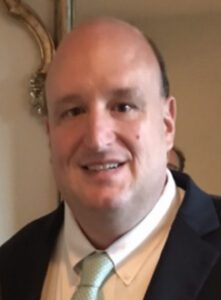
Title: President (Retired)
Company: G-R-Z.NET LLC
Location: Washington, Connecticut, United States
Geoffrey Zampiello, Retired President at G-R-Z.NET LLC, has been recognized by Marquis Who’s Who Top Executives for dedication, achievements, and leadership in systems engineering administration.
With more than 20 years of experience to his credit, Mr. Zampiello is currently retired, having most recently excelled as the president of G-R-Z.NET LLC between 1999 and 2021. During this time, he was additionally active with AT&T in a number of capacities between 1998 and 2015, including as a senior systems administrator, a senior network engineer, a team lead engineer, a corporate manager, a principle new technology product development engineer at AT&T Labs and a principle network planning engineer. Moreover, he served as a tier III support representative for SNET Internet from 1999 to 2000. Mr. Zampiello began his career as a manager for Woodbury Telephone Internet from 1998 to 1999.
Before embarking on his professional path, Mr. Zampiello pursued an education at Trinity College, from which he graduated with a Bachelor of Arts in psychology in 1998. He has 27 patents to his name, including patents for 911 internet call handling for VOIP calls and 911 VOIP internet traffic preservation. He likewise garnered two patents for Lawful Intercept supporting the U.S. Government’s CALEA (Communications Assistance for Law Enforcement Act) Program, known as “Aggregating and Capturing Subscriber Traffic,” through AT&T, which was verified by both the U.S. Patent and Trademark Office and the Law Offices of Amin, Turocy & Watson, LLP in 2018. He has also obtained patents concerning artificial intelligence in televisions, computers, and smartphone data processing and presentation, titled “Method and system for multicasting targeted advertising data” and represented by patent attorney G. Michael Roebuck. A former contributor to the ATIS J Standard for Broadband Lawful Intercept, Mr. Zampiello fondly recalls his brief work in supporting the Waterbury Connecticut Police Department with their information technology support, as he was able to aid detectives, vice and gang task forces, and their police patrol cars.
Mr. Zampiello has been likewise presented with the RICE Award for Excellence in IMS from AT&T. He attributes his success to his mentorship and encouragement from his father as well as his AT&T peer Bob Tyler. Notably, he is incredibly proud of having advanced with AT&T as a client sponsor, network planner and designer, a tenure in which he had to help with compliance with the U.S. Government’s CALEA Program following the events of September 11, 2001 and implemented orders from the U.S. Senate Judiciary Committee to provide real-time automatic broadband surveillance to law enforcement agencies via a presentation server at a moment’s notice. He learned a lot from his time learning from Anton Spagnolo’s leads from Study Group 3 especially Mike Pace who showed him the U.S. Government’s Mass Surveillance model that the National Security Agency was using to pick up any communications that Osama Bin Laden and Al Qaeda operatives had been sending via electronic email which is also the model used to deter any acts of terrorism or extremism. For the duration of the Implementation of the CALEA (Communications Assistance for Law Enforcement Act) Federal Mandate, Mr. Zampiello worked the dotted line for Mike Pace in the Spagnolo Organization of AT&T Labs Middletown, New Jersey. Tom Scholl, his coworker at AT&T in Meriden, Connecticut, once advised him that he inspected an email server that Al Qaeda had used.
As a result, Mr. Zampiello used this information he learned from Tom Scholl to make sure Study Group 3, the group he had chosen to implement the CALEA (Communications Assistance for Law Enforcement Act) Federal Mandate, placed the optical splitters required to intercept email and all Internet traffic at a place in AT&T’s consumer and business networks, where emails and all traffic could be intercepted across a network that was the country’s largest Broadband network at the time- AT&T.
Mr. Zampiello choose John Fisher and his direct report Mike Pace and the Study Group 3 model of surveillance gear that was already field-proven and provided AT&T’s non-government funding to Study Group 3 to once again deploy surveillance gear for America, according to the order given to Bob Tyler from the United States Senate Judiciary Committee to have broadband access lines from Internet users copied as a true and correct copy on a CALEA Router. He then had this captured traffic routed to a law enforcement agency network and presentation server in real time. The order from the United States Senate Judiciary Committee was qualified by technical requirements that were defined by the FCC First Report and Order and Memorandum Opinion and Order and the FCC Second Report and Order and Memorandum Opinion and Order. As a network planner and client sponsor and later a AT&T Labs designer he saw the CALEA Federal Mandate project through to its delivery on May 14, 2007 to the U.S. federal government. He also learned from FBI Engineering Research Facility Agent Ken Blackard, which was witnessed by David Greenberg of the FBI Dallas and Darrin Jones of the FBI Tech Liaison Office, a Supervisory Special Agent of the Operational Technology Division to develop a network to deter acts of domestic terrorism such as school shootings and building bombings.
Mr. Zampiello chose John Fisher and his direct report Mike Pace and the Study Group 3 model of surveillance gear that was already field-proven for use for the NSA Surveillance Program and provided AT&T’s non-government funding to Study Group 3 to once again deploy surveillance gear for America, this time for The CALEA (Communications Assistance for Law Enforcement Act) Federal Mandate; according to the order given to Bob Tyler from the United States Senate Judiciary Committee to have broadband access lines from Internet users copied as a true and correct copy on a CALEA Router. He then had this captured traffic routed to a law enforcement agency network and presentation server in real time. The order from the United States Senate Judiciary Committee was qualified by technical requirements that were defined by the FCC First Report and Order and Memorandum Opinion and Order and the FCC Second Report and Order and Memorandum Opinion and Order. As a network planner and client sponsor and later a AT&T Labs designer, he saw the CALEA Federal Mandate project through to its delivery on May 14, 2007 to the U.S. federal government. He also learned from FBI Engineering Research Facility Agent Ken Blackard, which was witnessed by David Greenberg of the FBI Dallas and Darrin Jones of the FBI Tech Liaison Office, a supervisory special agent of the Operational Technology Division to develop a network to deter acts of domestic terrorism such as school shootings and building bombings.
For more information, please visit:
Press Release
LinkedIn
Contact Mr. Zampiello:
